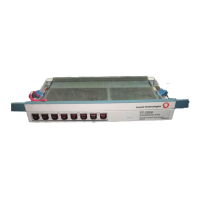Control, Transmission, and Synchronization Interfaces
Issue 8.0 July 2002
5-19
Network Synchronization 5
General 5
Careful consideration should be given to proper design of the SONET network's
synchronization. Proper synchronization engineering minimizes timing
instabilities, maintains quality transmission network performance, and limits
network degradation due to unwanted propagation of network synchronization
faults. The synchronization features of the FT-2000 OC-48 Lightwave System are
designed to complement existing and future network synchronization and, hence,
allow it not only to make use of network synchronization but also to take an active
role in facilitating network synchronization.
Several published sources give generic recommendations on setting up a
synchronization network. The FT-2000 OC-48 Lightwave System is designed to
operate in a network that complies with recommendations stated in
GR-436-CORE,
Digital Synchronization Network Plan
, Issue 1, June 1994;
GR-378-CORE,
Generic Requirements for Timing Signal Generators (TSG)
,
Issue 1, June 1995; and
ANSI
*
T1.101-1994,
American National Standard for
Telecommunications - Synchronization Interface Standards
. The following are
some key recommendations from these documents. For further detailed
explanation, consult the sources directly.
■ A network element can only receive the synchronization reference signal
from another network element that contains a clock of equivalent or
superior quality (stratum level).
■ The facilities with the greatest availability (absence of outages) should be
selected for synchronization facilities.
■ Where possible, all primary and secondary synchronization facilities should
be diverse, and synchronization facilities within the same cable should be
minimized.
■ The total number of network elements in series from the stratum 1 source
should be minimized. For example, the primary synchronization network
would ideally look like a star configuration with the stratum 1 source at the
center. The network elements connected to the star would branch out in
decreasing stratum level from the center.
■ No timing loops may be formed in any combination of primary and
secondary facilities.
The FT-2000 OC-48 Lightwave System supports the following applications (with
or without the FT-2000 OC-48 Repeater Bay) and network synchronization
configurations:
* Registered trademark of American National Standards Institute, Inc.

